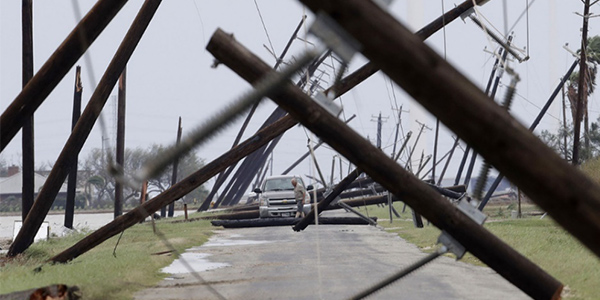The rapid restoration of electric service to customers in the southern U.S. following Hurricane Laura this summer was a testament to the need for collaboration between all industry stakeholders in an increasingly volatile hurricane environment, representatives of SERC Reliability and MISO told NERC’s Member Representatives Committee (MRC) on Thursday.
“2020’s been a record year in many ways, and it’s taken a lot of work by a large number of folks to get through this storm season, and we’re not done yet,” said Tim Ponseti, vice president of operations at SERC. “Hurricane Laura’s a tremendous example of our entire industry, along with regulators and the government … rising to the occasion and pulling together in a way that’s truly patriotic. … If only other parts of our country could pull together in a similar way.”
Strong Hurricanes a Known Threat
Grid operators knew by this spring that 2020’s hurricane season would be unusually active, with additional stress expected from the ongoing COVID-19 pandemic. (See Pandemic Adds to 2020 Hurricane Season Challenges.) But Laura proved an even trickier challenge than expected, growing in strength from Category 2 — with 100-mph sustained winds — to Category 4 — with sustained wind speeds of more than 150 mph. When the storm made landfall Aug. 27 near Lake Charles, hurricane-force winds were felt as far away as the Louisiana-Arkansas border.
The storm damaged or destroyed more than 1,900 transmission structures and damaged 430 substations, resulting in 342 initial sustained transmission line outages. More than 1 million customers lost power in Louisiana, Texas, Arkansas, Tennessee, Mississippi and Oklahoma. Damage estimates so far total more than $14 billion.
“We use the word ‘restoration’ a lot. This was not a restoration; this was a reconstruction for many pieces of the system,” said Todd Hillman, chief customer officer at MISO. “This was not like other storms, and the messaging [and] story around that was pretty important.”
Recovery work was further hindered by the arrival of Hurricane Delta, which made landfall Oct. 9 in Creole, La., just 12 miles east of the spot where Laura hit six weeks earlier. While Delta was a much weaker storm than Laura, at 100-mph sustained winds, and lost strength rapidly after landfall, it still knocked out some of the critical 500-kV lines that crews had restored following damage from Laura and caused 820,000 customers in four of the same states to lose power again.
Advance Prep Helped Speed up Response
Despite the devastation, crews worked rapidly to restore service; all customers affected by Laura regained electricity by Oct. 1, while the outages caused by Delta were addressed by Oct. 15. While some bulk electric system transmission lines remain under repair, the major lines serving their areas were restored by Oct. 18. Ponseti credited the effective response to SERC’s recognition of the growing threat from severe weather, particularly after the incorporation last year of the Florida Reliability Coordinating Council’s territory. (See FERC OKs SERC’s Expansion into Florida.)
“SERC’s regional risk report identified extreme weather as one of the top two risks the BES system faces within our footprint, and Hurricane Laura proved this point in spades,” Ponseti said. “And with the addition of the Florida peninsula to SERC, it’s almost impossible for hurricanes to miss the SERC footprint.”
Along with hurricane risk, the merger with FRCC also brought SERC a team of professionals experienced in dealing with severe weather, which the regional entity put to use as Laura approached to draw up a set of restoration guidelines to share with MISO, Entergy, Cleco Power and other utilities in its footprint.
‘Tough Calls’ Needed in Emergency
The guidelines include specific actions to be taken by the various types of entities. However, SERC placed the greatest emphasis on establishing industrywide coordination, with clear responsibilities and points of contact between SERC, MISO and utilities. Such arrangements are crucial for ensuring massive grid damage can be repaired both quickly and safely.
“When you’re in the middle of the event, the utilities of course want to get their members back online. One of the roles of an ISO/RTO is to take that wider system view,” Hillman said. “[That] made us make some tough calls … [because] we were understanding that there were bigger impacts and potentials if more of the system [came] down. … It’s not great to hear, ‘No, you can’t restore those customers yet; no, you can’t get that back online yet; we need to make sure that we’re sequencing this in the right way.’”
Although the arrival of Delta so soon after Laura put pressure on already hardworking crews, Hillman and Ponseti said the second storm did provide an opportunity to test what the entities learned from the first, “as the ink was still drying.” MISO, SERC and their utilities came away from the experience with a renewed appreciation for the fundamental work of thoroughly studying support requirements for extreme weather response; public communication to ensure that customers understand the scope of the problem; and above all, preparing staff through constant practice and assessments.
“You do a lot of drills, and you think to yourself, ‘Oh my gosh, it’s another drill. It’s another black start drill; it’s another system restoration drill,’” Hillman said. “Well, all those drills matter. It’s important to keep our operators trained … because when you’re in the heat of things, you … absolutely do not want to be the person that says, ‘Where do I find that information, and who do I talk to about it? How does that work?’ We didn’t have time to do any of that. And so [the] preparation and drills really played a key part in us getting the system back online.”





